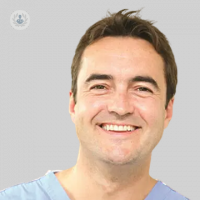Put your best foot forward with forefoot surgery
Written in association with:Alongside a variety of forefoot surgeries that address different conditions affecting this area, there are numerous reasons why people require it. You may need to relieve your pain, have a deformity treated or require the restoration of normal function in your forefoot.
Here to provide an expert guide to forefoot surgery, taking in its aims, what’s involved and its risks, among other in-depth points, is highly-experienced and respected consultant orthopaedic surgeon Mr Andrew Skyrme.

As an orthopaedic surgeon I carry out a significant amount of lower limb surgery including hip replacement surgery, knee replacement surgery, but also foot and ankle surgery.
What are the aims of forefoot surgery?
Within the foot and ankle, forefoot surgery is very common. This essentially involves surgery on the big toe, the lesser toes and the midfoot. The aims of surgery are generally to reduce pain, restore function and restore anatomy. A significant number of forefoot conditions cause deformity, that is to say crossing over of toes, hammer toes, bunions etcetera., all of which become uncomfortable, painful and make footwear very difficult.
What is the most common forefoot condition?
The most common forefoot conditions are bunions, which medically is known as hallux valgus, arthritis of the great toe, which is called hallux rigidus, and then lesser toe deformities. These are generally hammer toes, claw toes and mallet toes. Surgical correction of these conditions is relatively straightforward.
What’s involved in surgery for this condition?
For the great, or big, toe it involves a corrective osteotomy which effectively involves breaking and straightening the great toe, which can be done minimally invasively. Arthritic great toe conditions generally involve clean-up of the great toe which is called a cheilectomy, or a fusion of the great toe.
Fusion of the great toe is an excellent operation in resolving pain completely and despite pre-conceived ideas of reduction in movement, it is amazingly well tolerated with great functional results.
Lesser toe corrections likewise are reasonably straightforward and involve breaking and straightening the toe and fixing it with small wires for a period of weeks.
The recovery from this type of surgery is generally six weeks in a heavy bandage with reduced activity. The patient is able to walk around, but with reduced activity.
What are the risks of forefoot surgery?
After surgery, one needs to elevate the foot to reduce swelling. There are risks associated with forefoot surgery, which include under correction, over correction, infection, thrombosis, mal-union, non-union and nerve injury.
As a rough guide the satisfaction with forefoot surgery is in the order of 85 per cent. To retain a high percentage of satisfaction it involves adherence to instructions, which effectively are after the operation, elevation of the limb to reduce swelling and we often use protected weight-bearing, that is to say crutches, for a few weeks.
As a lower limb surgeon, I carry out hundreds of forefoot operations per year to correct these deformities; the most common being bunions, arthritic great toes and lesser toe deformities.
If you’re looking for relief from forefoot deformity, pain or incorrect functioning, and require expert surgery, arrange an appointment with Mr Skyrme via his Top Doctors profile.



